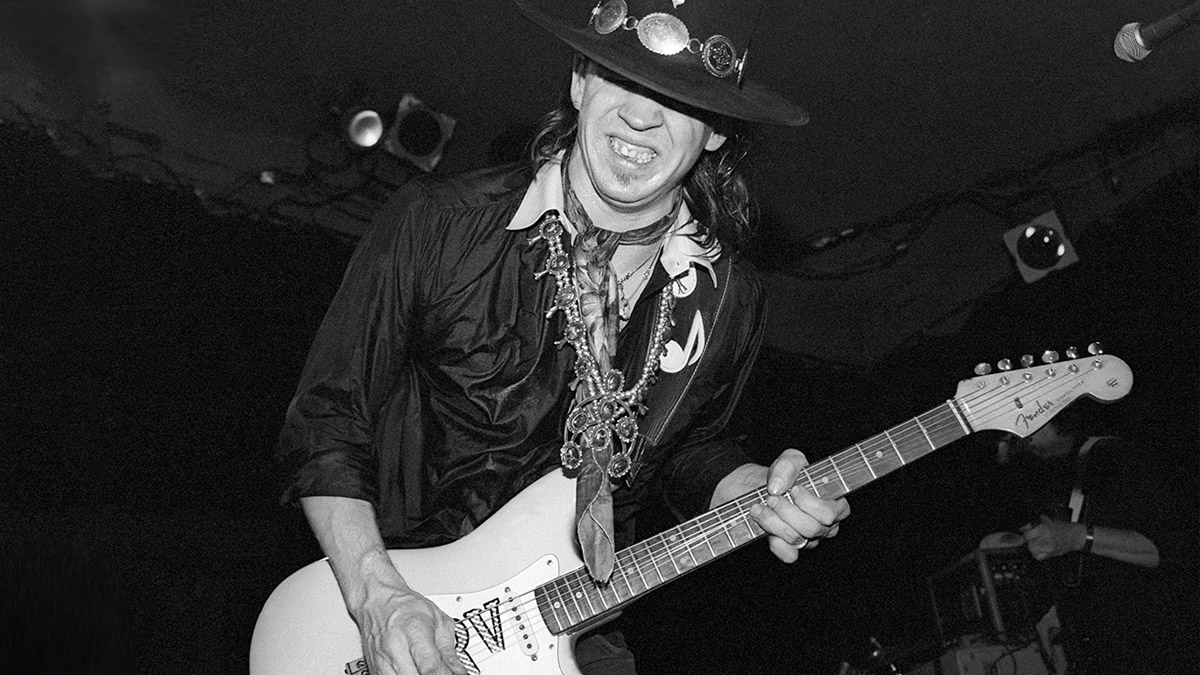Stevie Ray Vaughan virtually defined the art of the Texas shuffle – learn the playing style that shaped the sound of blues to come
The late, great Stratocaster master’s techniques will add some Texas heat to your blues playing, guaranteed

Stevie Ray Vaughan remains one of the most celebrated and enigmatic guitarists to emerge from the Texas blues scene. Stevie’s career lasted only seven years from the release of his studio debut album, Texas Flood in 1983, to his untimely death in 1990. But this was enough to establish Vaughan as one of the greatest blues guitarists of all time.
Stevie’s guitar playing revealed many influences which he delivered in his unique and flamboyant style. His main influence was Jimi Hendrix, with Stevie borrowing both lead and rhythm ideas including fiery pentatonic lines, and chord embellishments. He would go on to cover some of Jimi’s tunes including Voodoo Chile and Little Wing.
He was also influenced by blues greats such as Albert King, Freddie King, Albert Collins and Lonnie Mack, resulting in a more traditional blues sound to his leads. This is evident in such tracks as Texas Flood and Tin Pan Alley.
There was also a strong element of jazz in Stevie’s playing, since he listened to Kenny Burrell, Wes Montgomery and Django Reinhardt. Tracks such as Riviera Paradise, Lenny, and Stang’s Swang are great examples. Stevie was also heavily influenced by his brother Jimmie Vaughan, with whom he released the album Family Style, in 1990.
Stevie had real groove in his playing. He had incredible control of his picking hand, yet the ability to sit back in the pocket of a groove, virtually defining the art of the Texas shuffle. His ability to mute strings while striking the guitar with large picking-hand movements, added a percussive element to his rhythms.
Great examples of this are Change It, Cold Shot, Pride And Joy, as well as the jaw dropping Rude Mood which, although has a straight groove, is a great example of his rhythm prowess. Stevie would also add this approach to lead licks, pedalling off of the sixth string, fretting notes with his thumb while embellishing with Pentatonic double-stops, demonstrated in the iconic Couldn’t Stand The Weather.
In this feature we are going to look at some of the key elements that have cemented SRV as one of the greats, as well as giving you some fresh ideas to add some Texas fire to your playing.
All the latest guitar news, interviews, lessons, reviews, deals and more, direct to your inbox!
Get the tone
Amp Settings: Gain 3, Bass 7, Middle 6, Treble 7, Reverb 2
Stevie is best known for playing Fender Stratocasters, and his main amp choice was Fender, often driven by a Tube Screamer, but he also used Marshall and Dumble. Other effects included a Fuzz Face, wah pedal and a Uni Vibe. For an authentic SRV tone, go for middle or neck position single coil pickup, aim for a moderate TS style overdrive, with boosted mid range, and bags of attitude.
Example 1. Texas shuffle
We start withan example of Stevie’s Texas shuffle. The riff is based around a I-IV-V in E. We kick off with a figure based around the E major chord, outlining a minor to major tonality for tension and release. Keep the picking hand relaxed, and aim to strike muted strings when playing the single notes. The aim here is groove, so keep a constant swing rhythm with your picking hand.
Over the A chord we add a quarter tone bend to the C note in the root of the chord before concluding with an implied A5 to G5, with the root notes fretted with your fretting-hand thumb. The V chord has some added Hendrix influence with the B7#5 chord as well as the double-stop chord fills. This example also includes double-stop fills plus an open position E minor pentatonic lick, so take care.
Example 2. Adding double-stops
This example demonstrates how Stevie would employ double-stops to his solos to add excitement as well as traverse the neck. This lick kicks off with a Hendrix-style unison figure on the top two strings. Be sure to add the quarter-tone bend on the second string for the figure in bar 2.
Following on from the climbing double-stops we conclude with more Hendrix-inspired double-stops with bends and hammer-ons. There’s a lot going on here to keep you on your toes!
Example 3. Negotiating the I-IV chord move
This piece illustrates an example of Stevie’s soulful blues lead playing, drawing influence from Albert Collins and Albert King. Based around an A dominant blues, it demonstrates how Stevie negotiates the I-IV chord move.
Pay attention to the climbing bending figure in bar 5, making sure you catch the second string when bending the first string. Bars 6-7 conclude with a signature Stevie pentatonic hammer-on and pull-off lick.
Example 4. SRV blues-rock style
This example highlights Steve’s more straight-ahead blues-rock approach. It’s based around the E minor pentatonic scale utilising shape 1 and shape 2. Pay attention to the lick at bars 4-5, where each of the bends fall on a different part of the beat as the lick repeats.
The example concludes with a rhythmic figure using double-stops played on the fourth and third strings, embellished with E notes played with the fretting-hand thumb at the 12th fret.
Example 5. The jazz influence
Our final idea shows some of Stevie’s jazz-inspired lines, and how he plays melodies around chord shapes. Play attention to the lick at bar 2, using pick and fingers to achieve the melody while playing the 5th fret, first string.
This figure includes embellishment using double-stops built around chord shapes. Make sure all the notes are allowed to ring clearly when adding hammer-ons to the double-stops. Also, embellish the chords with subtle whammy bar vibrato.
Jamie Humphries is an English guitarist based in Sweden. He has toured and performed with artists such as Brian May, Queen, Jeff Beck and Henry Rollins, as well as performing across Europe for We Will Rock You and in America with the Australian Pink Floyd Show. He was a longtime contributor to Guitar Techniques magazine and contributes lessons for Gibson. He runs his own studio in Stockholm where he produces Youtube content for Six String Alliance and Produce Like A Pro. He is a Music Man and Mesa/Boogie endorsee.

